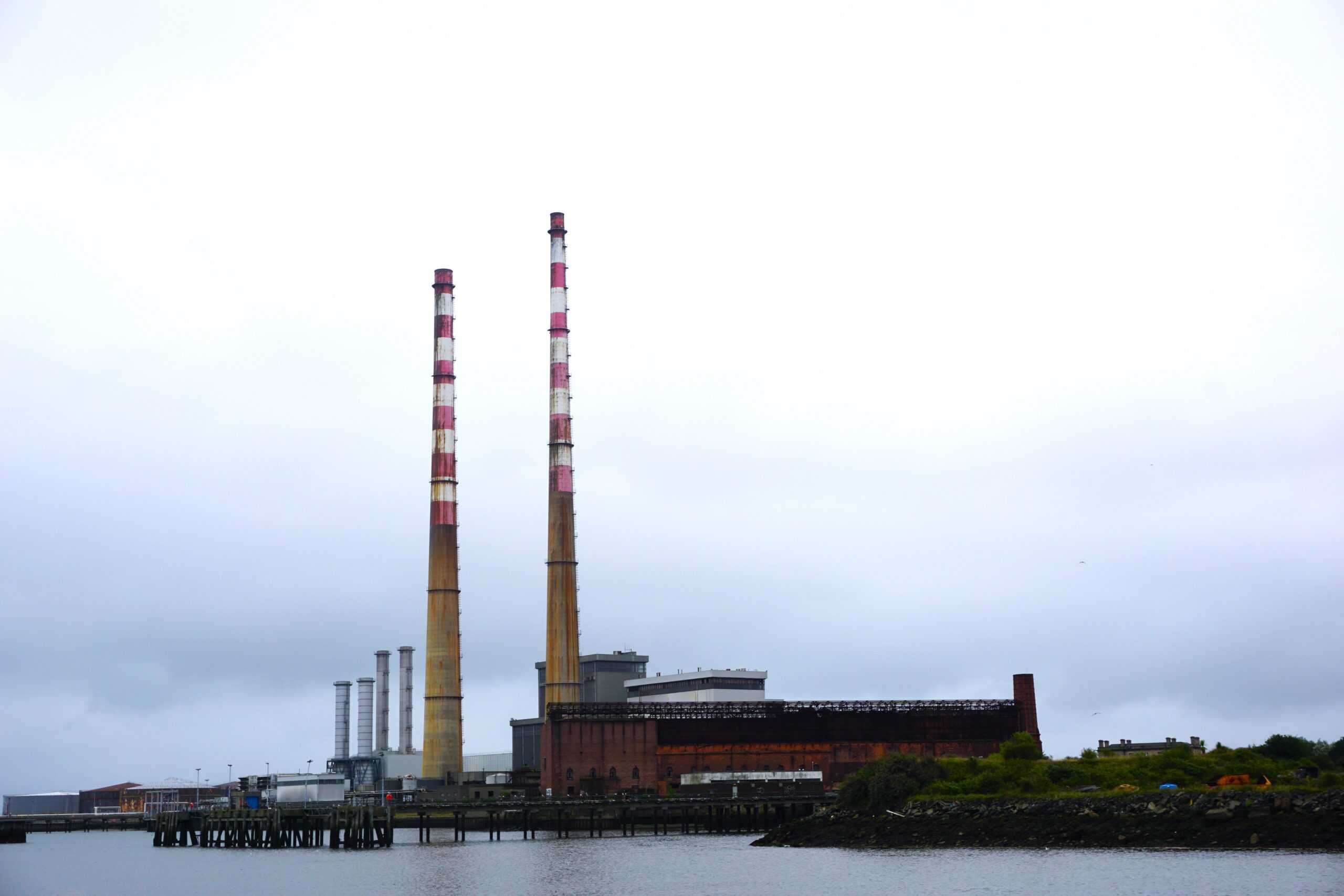39 Famous Landmarks in Dublin You Need to Visit
Looking for the most famous landmarks in Dublin?
Then you’ve come to the right place!
The Irish capital has a rich history, dating back centuries. Over the years, this ancient city has transformed from Celtic homesteads to a thriving Viking port. It’s been an important Medieval town and at one point the second city of the British Empire. Dublin was the epicenter of the battles that won Ireland its independence and continues to draw millions of visitors from around the world.
I’m fortunate to live in Dublin and get to experience and learn about this vibrant, historical city on a daily basis. I’ve visited many iconic Dublin landmarks that showcase the rich and diverse history of the city.
Below, I’ve compiled a list of the most famous landmarks in Dublin to inspire your travels. They vary in terms of significance, but each one is an important part of the Dublin landscape and represents a different aspect of this wonderful city.
Please note this post may contain affiliate links. If you click on one, I may earn a small commission at no extra cost to you. See my Privacy Policy for more information.
39 Famous Landmarks in Dublin
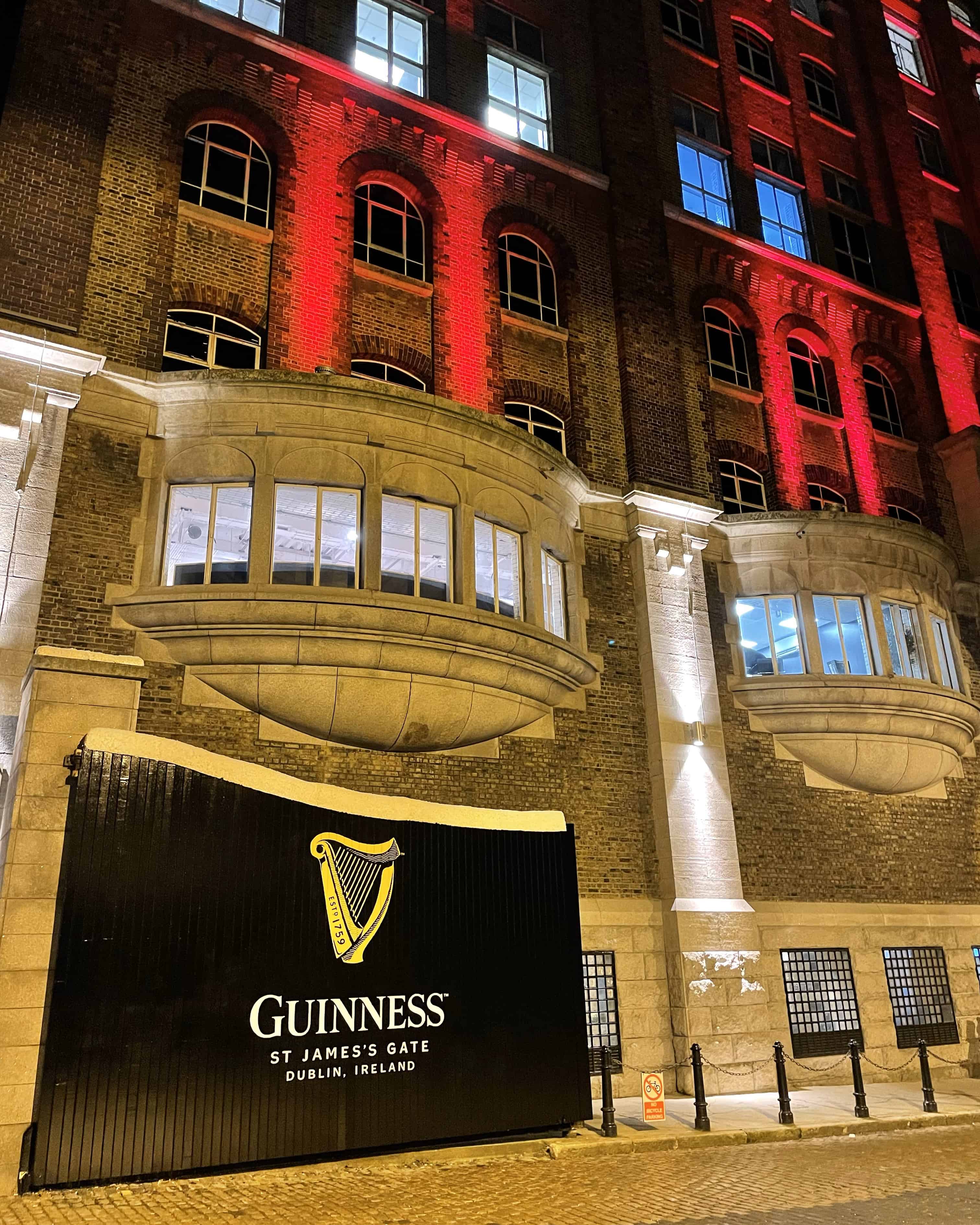
1. Guinness Storehouse
In Dublin’s Liberties neighborhood is the most famous landmark in Dublin: The Guinness Brewery at St James Gate. It’s a bit of a cliche to say that Irish people love Guinness, but then again a cliche has to stem from somewhere.
Guinness is the most popular stout in the country (perhaps the most popular drink in the country — more than whiskey!), and the Guinness family had a profound and lasting effect on the city of Dublin. This philanthropic family endowed the city with parks and hospitals that continue to benefit residents a century on.
The Guinness Storehouse is equal parts museum and Disney-esque Guinness experience, and the best way to learn about why Guinness is such an important part of the Irish psyche. It’s also the top tourist attraction in the country, and a must-see when coming to Dublin.
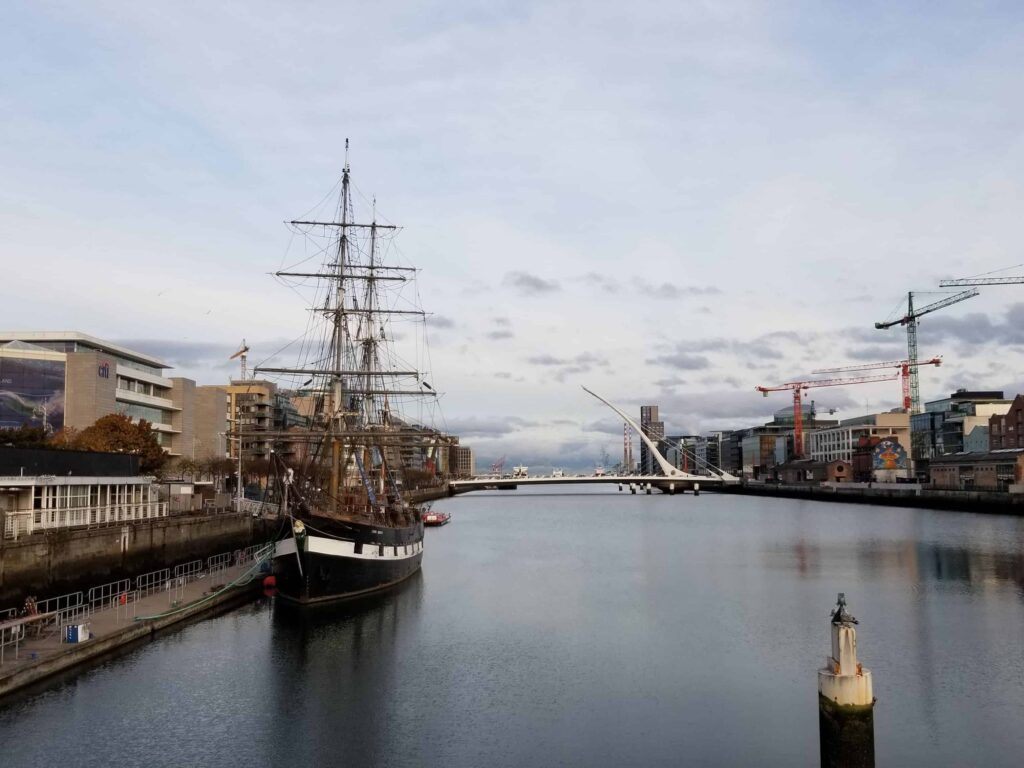
2. Jeanie Johnston
This replica of a 19th-century coffin ship sits on the north bank of the River Liffey, reminding passersby of the darkest period in Irish history.
The Irish Famine (referred to locally as The Great Hunger) saw the death of 1 million Irish people due to starvation and hunger. Another 1 million people emigrated on ships just like Jeanie Johnston.
You can visit the ship on a guided tour where you’ll learn about the appalling conditions found aboard these overcrowded vessels. Passengers were crammed into dark, too-small spaces with poor sanitary conditions and little to eat, and many did not survive the passage.
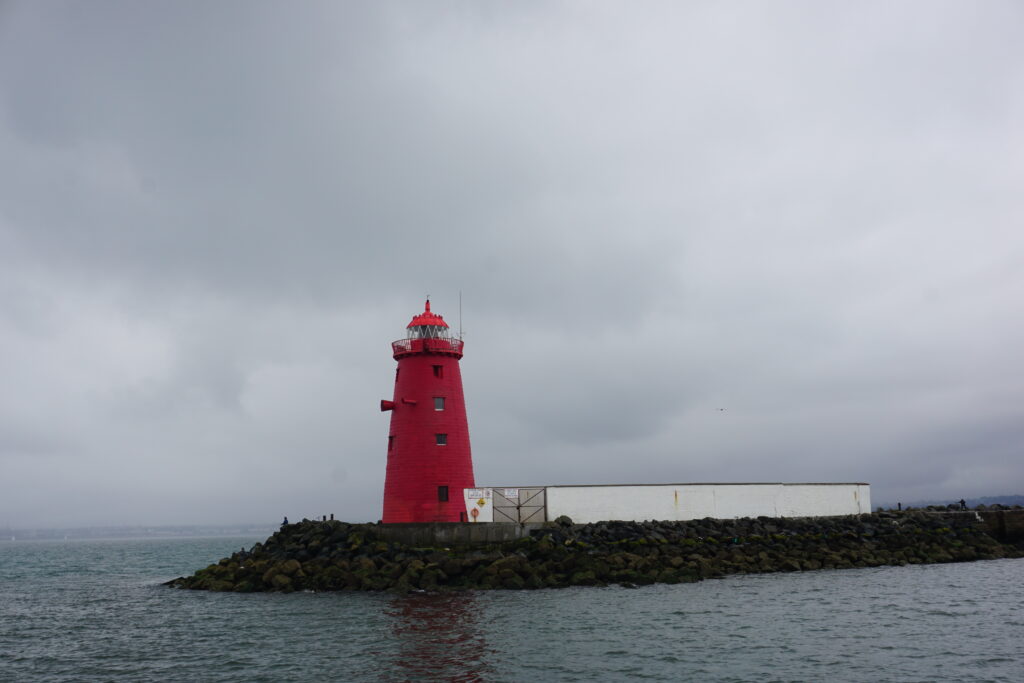
3. Poolbeg Lighthouse
If you arrive in Dublin via ferry, this small red lighthouse welcomes you to the city. Built in 1767, this iconic Dublin landmark marks the entrance to Dublin Harbor.
The lighthouse is built at the end of the Great South Wall, once the longest breakwater in the world and one of two that corral boats to the port. One of the best ways to see the lighthouse is on a boat tour of Dublin Harbor, which takes you right past the building.
You can also walk to Poolbeg Lighthouse along the Great South Wall, which is one of the best walks in Dublin.
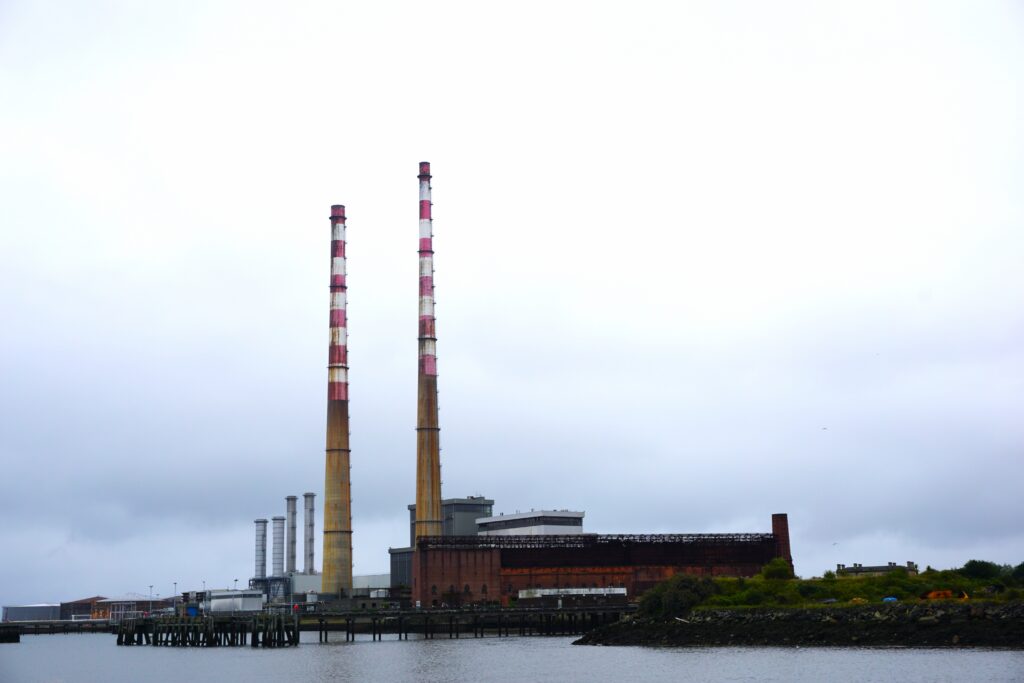
4. Poolbeg Chimneys
No other structure in Dublin is as beloved by locals as the Poolbeg chimneys. These white and red striped smokestacks are the tallest structures in Ireland and the telltale markers of the Dublin skyline.
The chimneys once smoked up the sky, but when the Poolbeg Generating Station was decommissioned in 2010, they sat dormant with an uncertain future. Dubliners rallied around saving the smokestacks, and in 2014 they were listed as protected structures.
Today, the Poolbeg Chimneys continue to tower over Dublin, and you can find their image on souvenirs from candlesticks to tote bags.
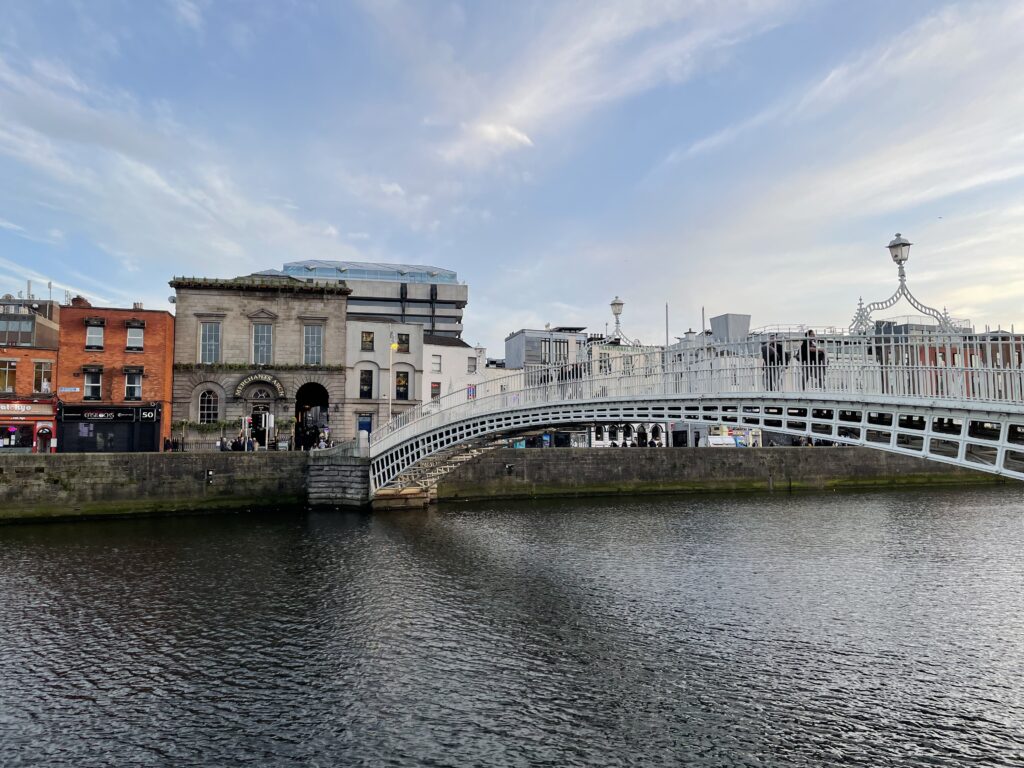
5. Ha’Penny Bridge
Dublin’s Ha’Penny Bridge spans the River Liffey, connecting the city’s past and present. In the early 19th century, it was a modest toll bridge, charging half a penny for each pair of shoes walking the bridge. To save money, Dubliners would carry their wives across the bridge to avoid paying two fares.
Although the bridge is technically named the Liffey Bridge, no one refers to it as such and instead use its nickname, Ha’Penny Bridge, after the half-penny fee once charged.
With its cast-iron curves and practical design, the bridge is one of the more aesthetically pleasing bridges that span the Liffey. Though the toll is long gone, the Ha’Penny Bridge remains one of Dublin’s iconic landmarks. It’s a reminder of a bygone era and the evolving narrative of a city that holds tightly to its history while forging ahead into the future.
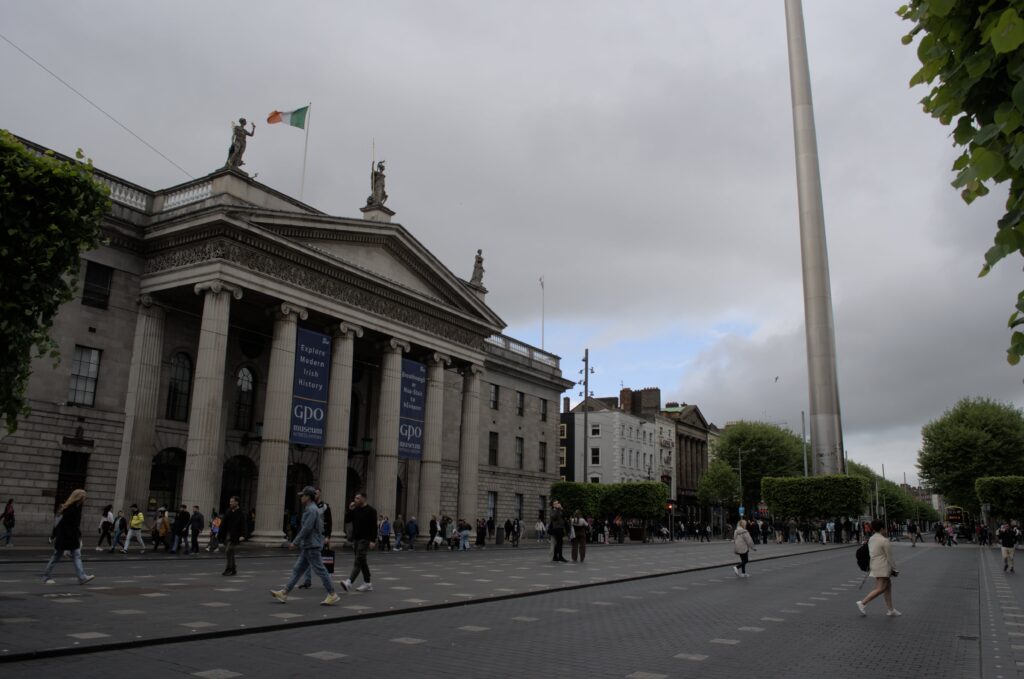
6. General Post Office (GPO)
Dublin’s General Post Office (GPO) stands as a testament to Ireland’s turbulent past. This building played a pivotal role in the nation’s history.
Dominating O’Connell Street with its imposing neoclassical façade, the GPO is more than just a postal hub; it’s a living chronicle of Ireland’s fight for independence. In 1916, the GPO became the headquarters of Irish Rebels during the Easter Rising. Although the Rising was deemed a failure, it turned the tide of Irish nationalism and ultimately led to the country gaining independence from its British colonists.
To this day, the building bears the scars of battle. If you look closely, you can see damages to the facade as a result of gun battles waged over 100 years prior.
The General Post Office still operates as a working post office, but inside you’ll also find the GPO Museum, which meticulously details the events of the Easter Rising. It’s one of my favorite museums in Dublin and provides great context for understanding 20th-century Irish history.
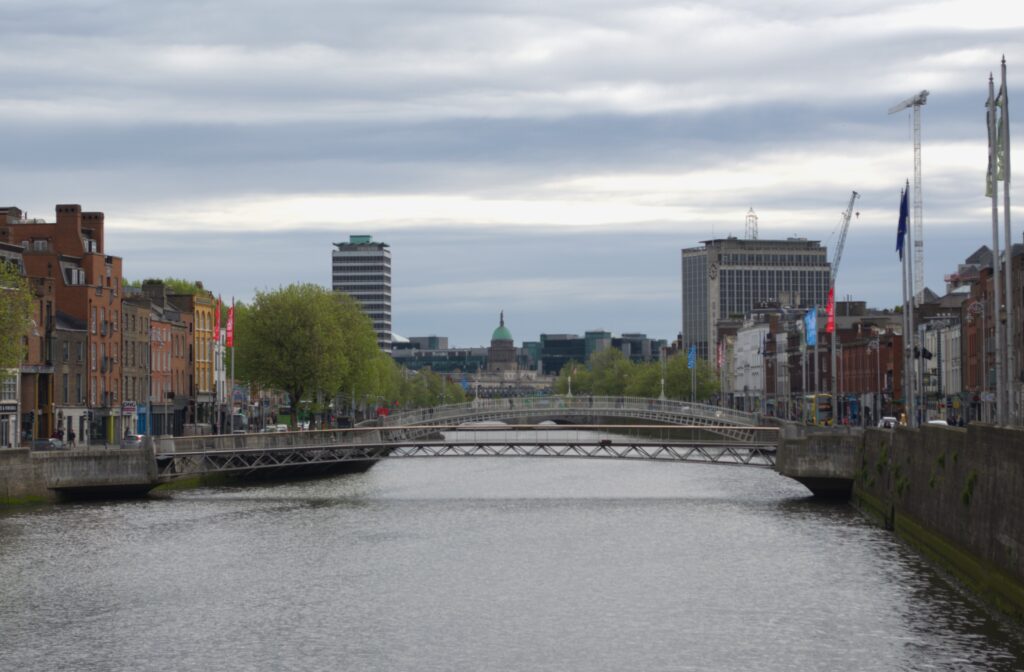
7. River Liffey
The River Liffey meanders through the heart of Dublin, bisecting the city into two distinct sections. The Liffey flows for 132 km (82 miles) and through three counties before its termination at the Irish Sea.
The shores of the Liffey are the origin story of Dublin, going back over 1,000 years to the Viking invasions. They sailed into Dublin harbor with their longboats and fought, pillaged, and then ultimately settled along the river’s shores. Here they mingled with the native Irish, blending with the population and establishing the Viking town of Dyflin that eventually became modern-day Dublin.
The River Liffey is synonymous with Dublin and has been featured in poems, songs, and paintings by prolific Irish artists and writers.
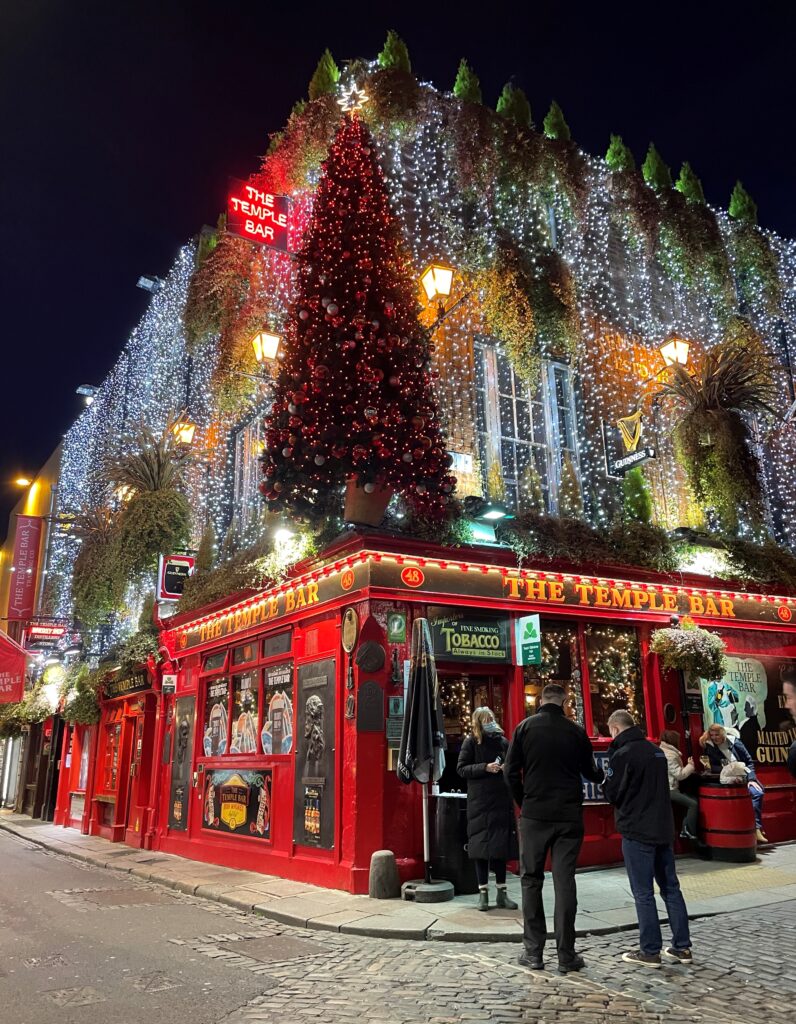
8. Temple Bar Pub
I have mixed feelings about including this pub in a list of Dublin’s landmarks, but it has become an iconic meeting point in Dublin’s city centre.
While locals wouldn’t be caught dead sipping a pint here, Temple Bar Pub is a popular place for tourists visiting Dublin. With its bright red facade, big gold letters, and colorful flowers (or huge Christmas tree in the winter), Temple Bar Pub stands out in the crowded Temple Bar neighborhood, drawing people in for a bit of craic (the Irish word for fun).
The pub has live music daily and is a lively spot to grab a drink. While you won’t get a local experience there, it’s still worth visiting if you’re looking for a lively party atmosphere.
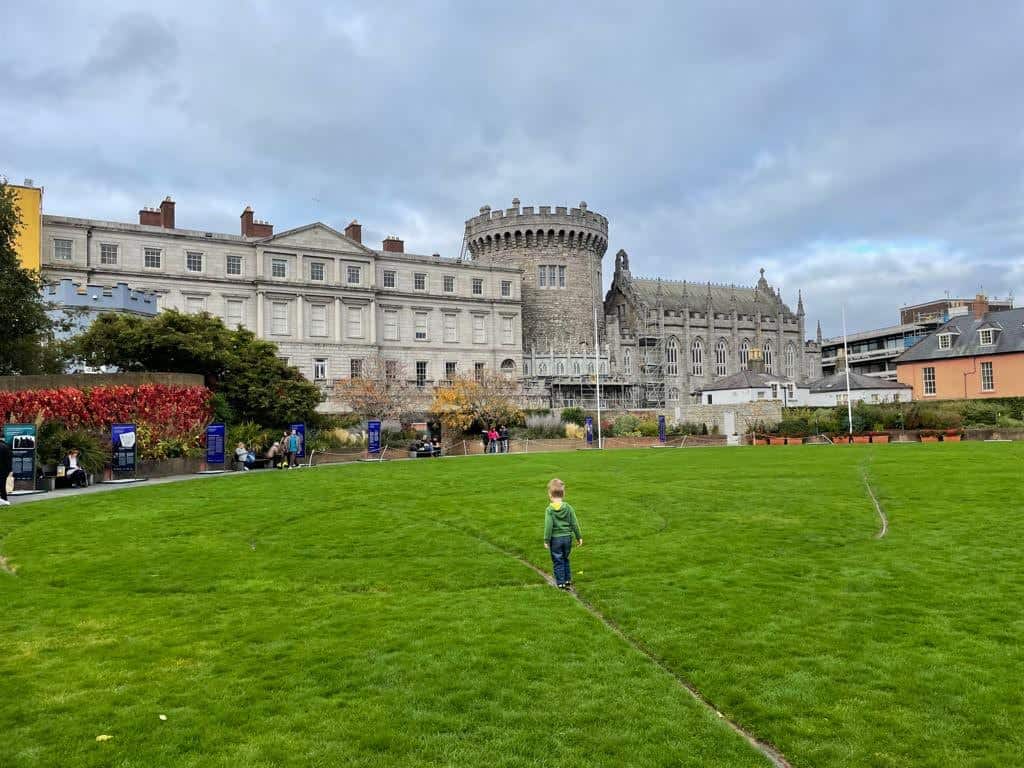
9. Dublin Castle
Dublin Castle stands as a silent witness to centuries of Irish history. Built in the 13th century by order of King John of England, it was initially a military fortress and a symbol of Norman authority in Ireland. Over time, the castle evolved from a stronghold into the administrative center of British rule in Ireland.
Throughout its existence, Dublin Castle has been at the center of pivotal moments in Irish history. It hosted English monarchs, endured sieges, held captured leaders of the 1916 Easter Rising, and became a focal point for Irish political life.
In 1922, Dublin Castle was at the center of history yet again as the location where the British ceded power to the Irish Free State. The castle has transitioned from a seat of colonial power to a symbol of Irish independence.
Visitors to Dublin Castle can tour the staterooms and the adjacent Norman Chapel, and learn about Ireland’s complex history.
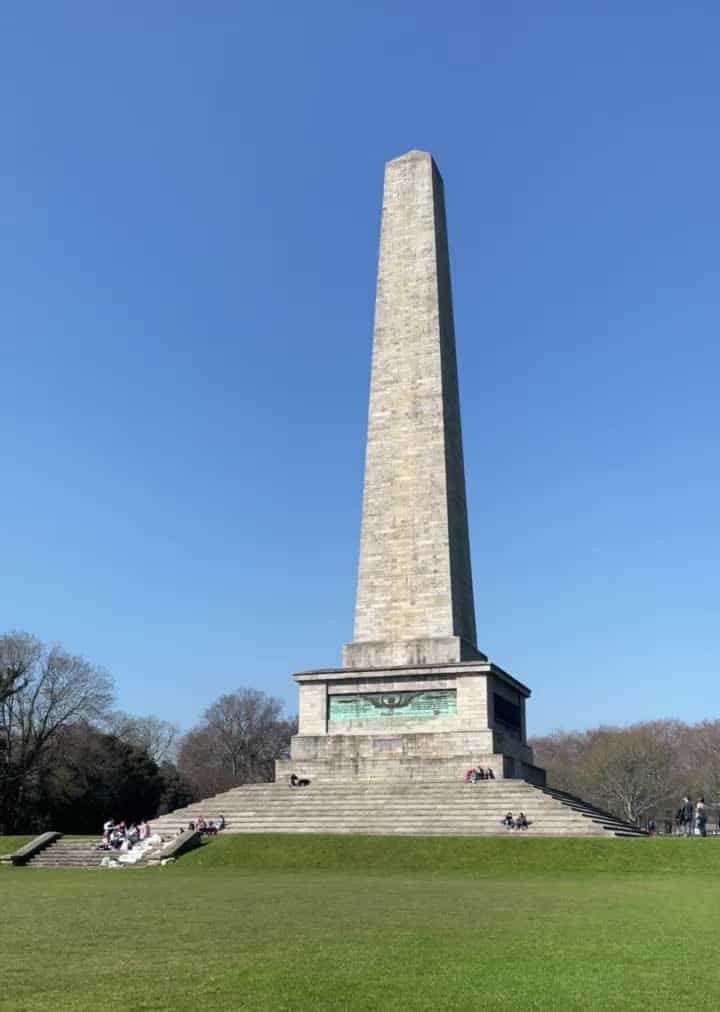
10. Wellington Monument
If you head to Phoenix Park, you’ll see a commanding obelisk piercing the sky. This is the Wellington Monument, a tribute to the former Duke of Wellington, Arthur Wellesley.
Constructed in the mid-19th century, this structure commemorates Wellington’s military achievements, notably his victory against Napoleon at the Battle of Waterloo in 1815.
Rising over 200 feet, the monument is Ireland’s tallest obelisk. Originally intended as a testimonial to Wellington’s military prowess, the monument also holds connections to Ireland’s complex past. Wellington, despite his victories, faced criticism for his political stance on Irish issues.
Today, the monument remains a fixture in Phoenix Park. You can walk up the base of the monument and sit along its steps, or admire it from afar while strolling the park.
11. St Patrick’s Cathedral
St. Patrick’s Cathedral, one of Ireland’s most famous cathedrals, symbolizes centuries of Irish history.
Founded in 1191, this imposing structure is the largest cathedral in Ireland and the National Cathedral of the Church of Ireland. The cathedral is dedicated to St. Patrick, the patron saint of Ireland, famous for banishing snakes from the island. Its origins trace back to the early Christian era and is believed to be built on top of the original site where St. Patrick baptized the Irish and converted them to Christianity.
The interior of St. Patrick’s Cathedral is beautiful, with high Gothic arches, a choir, and colorful stained glass windows. The site is open to visitors daily, but be sure to check the hours as it may be closed for services.
12. Brazenhead Pub
In the center of the city is the Brazenhead Pub, the oldest pub in Dublin and one of the oldest buildings in Dublin. There’s been a pub on this spot since 1198, and the current building dates back to 1754.
Inside you’ll find dimly lit rooms with worn wooden beams and weathered stone walls. It’s cozy, serving up hearty plates of traditional Irish pub food, cold pints of Guinness, and live music every evening (in other words, the perfect place to pass a rainy day in Dublin).
13. Daniel O’Connell Statue
Standing proudly along Dublin’s bustling O’Connell Street is the commanding statue of Daniel O’Connell, a revered figure in Irish history. Known as “The Liberator,” O’Connell tirelessly fought for civil rights and Catholic emancipation in 19th-century Ireland, leaving an indelible mark on the nation’s narrative.
Cast in bronze, the statue captures O’Connell’s resolute presence, symbolizing his unwavering dedication to the Irish cause. Positioned amidst the bustle of the city, it serves as a powerful reminder of O’Connell’s enduring legacy and ongoing pursuit of freedom and equality.
14. The Spire
The futuristic, needlelike sculpture at the top of O’Connell Street is “The Millenium Spire.” This slender sculpture towers over the buildings of the city center, a reminder of when we celebrated the coming of the new millennium. Ironically, this 120-meter tower wasn’t completed until January of 2023.
The Spire of Dublin was built on the spot that once held a monument to Lord Nelson, which was bombed in 1966 by the IRA.
The official name is the Monument of Light, but it has many nicknames. My favorite, and probably the one that best showcases Irish humor, is “The Erection at the Intersection.”
15. Christ Church Cathedral
On the south bank of the river, Dublin’s Christ Church Cathedral stands as a cornerstone of the city’s history, tracing its origins back over a millennium.
Founded in the 11th century, this grand cathedral represents a blend of architectural styles, reflecting centuries of evolution and reconstruction.
Steeped in both religious and historical significance, Christ Church Cathedral holds an important place in Ireland’s history. Throughout the centuries, it’s served as a center of worship, witnessed royal coronations, and born witness to pivotal moments in Ireland’s past.
As one of the top historical landmarks in Dublin, Christ Church Cathedral’s towering spire and timeless beauty welcome travelers and locals alike.
16. The “Black Pool”
The name “Dublin” is the Anglicized pronunciation of the city’s original Viking name, “Dyflin,” meaning “Black Pool.” The name refers to the place where the Poddle and Liffey rivers meet. The Viking “Dyflin” became “Dubh Linn” in Irish, then eventually morphed into Dublin.
While the pool no longer exists, its original location behind Dublin Castle is marked with a lovely green and gardens.
Where the pool once was, you’ll find outdoor sculptures and the renowned Chester Beatty Museum, one of Dublin’s many free museums.
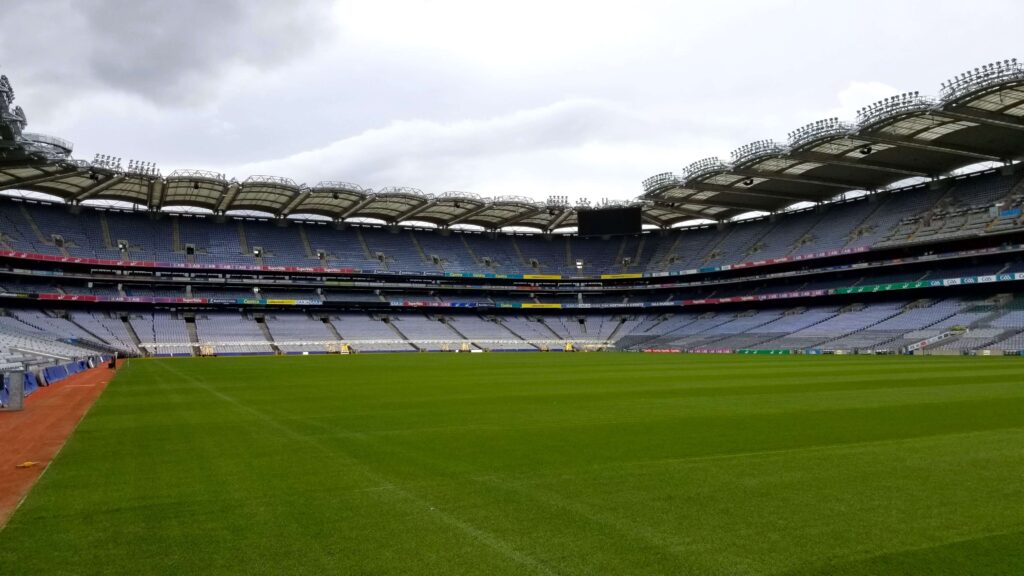
17. Croke Park
Croke Park is the national stadium for the Gaelic Games and one of the best landmarks to visit if you’re a sports fan. Every summer, people from across the island flock to the stands to root for their county teams in the All-Ireland Finals.
Gaelic sports are the traditional Irish games and some of the most intense and fast-paced sports in the world. Watching them, you’d never believe that these incredible athletes are considered amateurs (they don’t get paid to play), and hold down full-time jobs outside the sport.
But Croke Park is more than a stadium, it’s also one of the most important historical sites in Dublin. In 1920, Croke Park was the site of the Bloody Sunday killings, when British forces opened fire on the crowd attending a Gaelic football match, killing 14. The excellent museum inside the stadium recounts this gruesome event and pays homage to the victims.
18. Aviva Stadium
The sleek curvature and modern design of Aviva Stadium stands out in the Dublin skyline. This beautiful modern stadium is home to the Irish national rugby team.
The stadium opened in 2010 and can fit over 50,000 spectators. In addition to rugby, large events are held here. Big-name performers, such as Harry Styles, have played to sold-out crowds at Aviva.
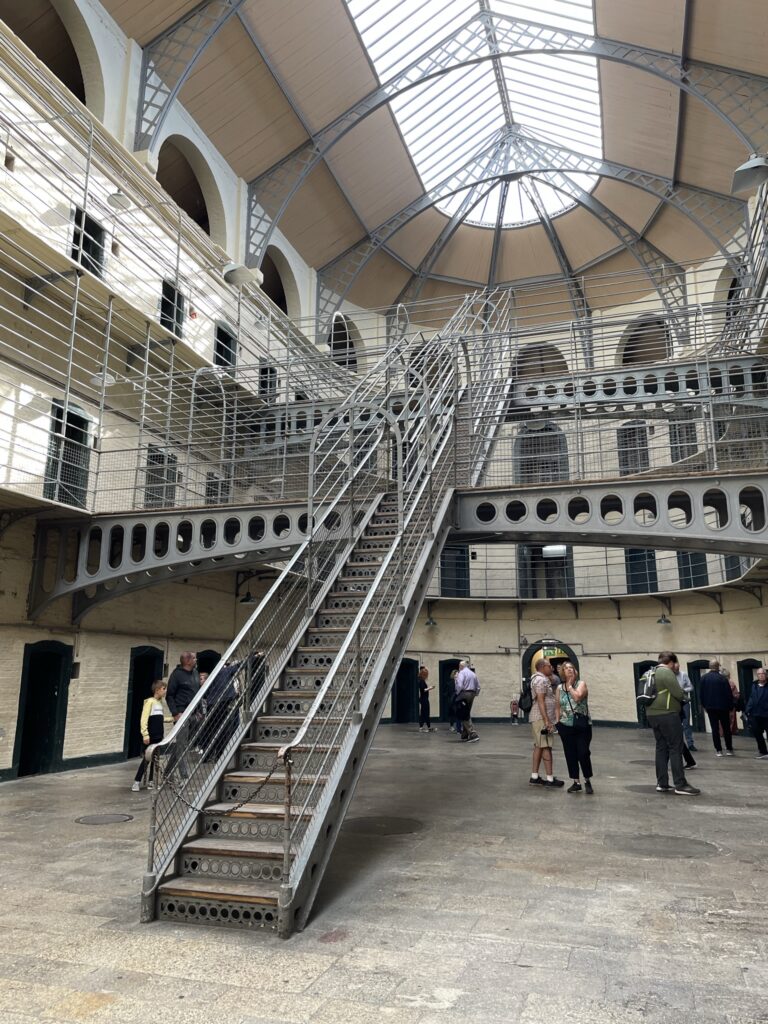
19. Kilmainham Gaol
On the fringes of Dublin City, Kilmainham Gaol stands as a poignant reminder of Ireland’s tumultuous past. Once a stark symbol of British colonial rule, the building is now a museum of Irish resilience, defiance, and resistance.
Your visit to Kilmainham begins with a guided tour of the prison wards, transporting you back hundreds of years to when the jail was overcrowded with desperate people who flocked to Dublin to escape the Irish famine. During this time, children as young as four years old were imprisoned in these walls.
But perhaps the most important period in Kilmainham’s storied history was after the 1916 Easter Rising when British forces imprisoned and subsequently executed the Irish rebel leaders here in these cells.
The men were teachers, poets, and revered members of their communities. Their execution, decided by a military court, was carried out right here in the jail’s courtyard. This singular event changed the tide of the Irish liberation movement and garnered nationwide support for the cause of Irish independence.
20. Áras an Uachtaráin
Áras an Uachtaráin, located in Dublin’s Phoenix Park, the largest park in Dublin, holds significant importance as the official residence of the President of Ireland. Built in the 18th century, this stately mansion serves as the home and workplace of the President, playing a pivotal role in the country’s governance.
The building was originally constructed as a residence for the Viceregal representatives of the British Crown. Since Ireland gained independence, it has been the residence of every Irish president. Its historical significance lies in transforming from a symbol of colonial authority to a representation of Ireland’s sovereignty.
While primarily serving as the President’s official residence, the Áras also hosts state events, ceremonies, and diplomatic meetings.
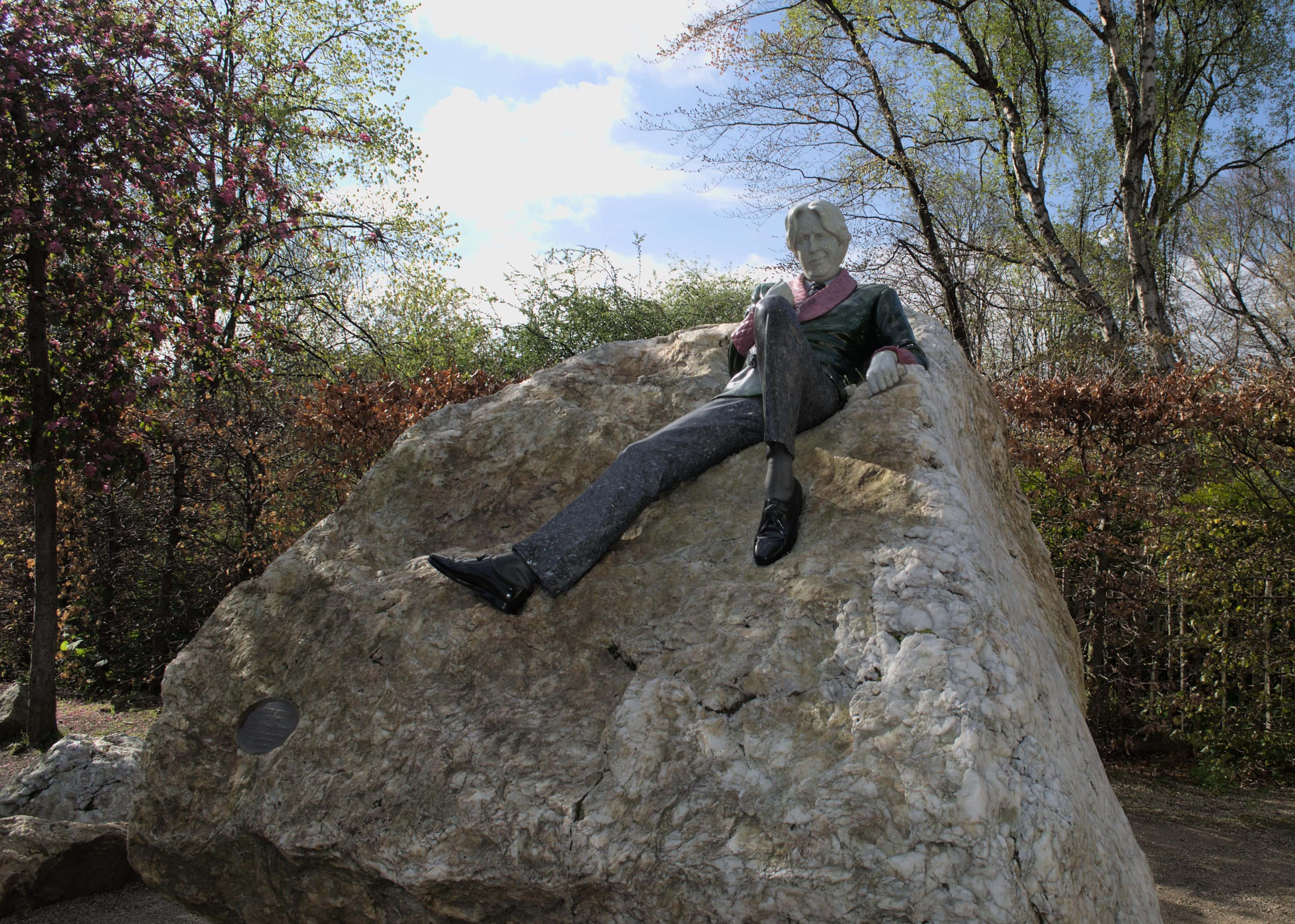
21. Oscar Wilde Statue
At the northwest corner of Merrion Square is a tribute to one of Dublin’s most renowned writers: Oscar Wilde. The statue was unveiled in 1997 and captures Wilde lounging on a large granite rock while smirking at passers-by.
The location of the statue is purposeful — located just across the street from Wilde’s childhood home.
While many visitors flock to see the famous statue, I find it off-putting. While I suppose it captures Wilde’s eccentric nature, I find the unconventional pose and sarcastic facial expression a little unsettling.
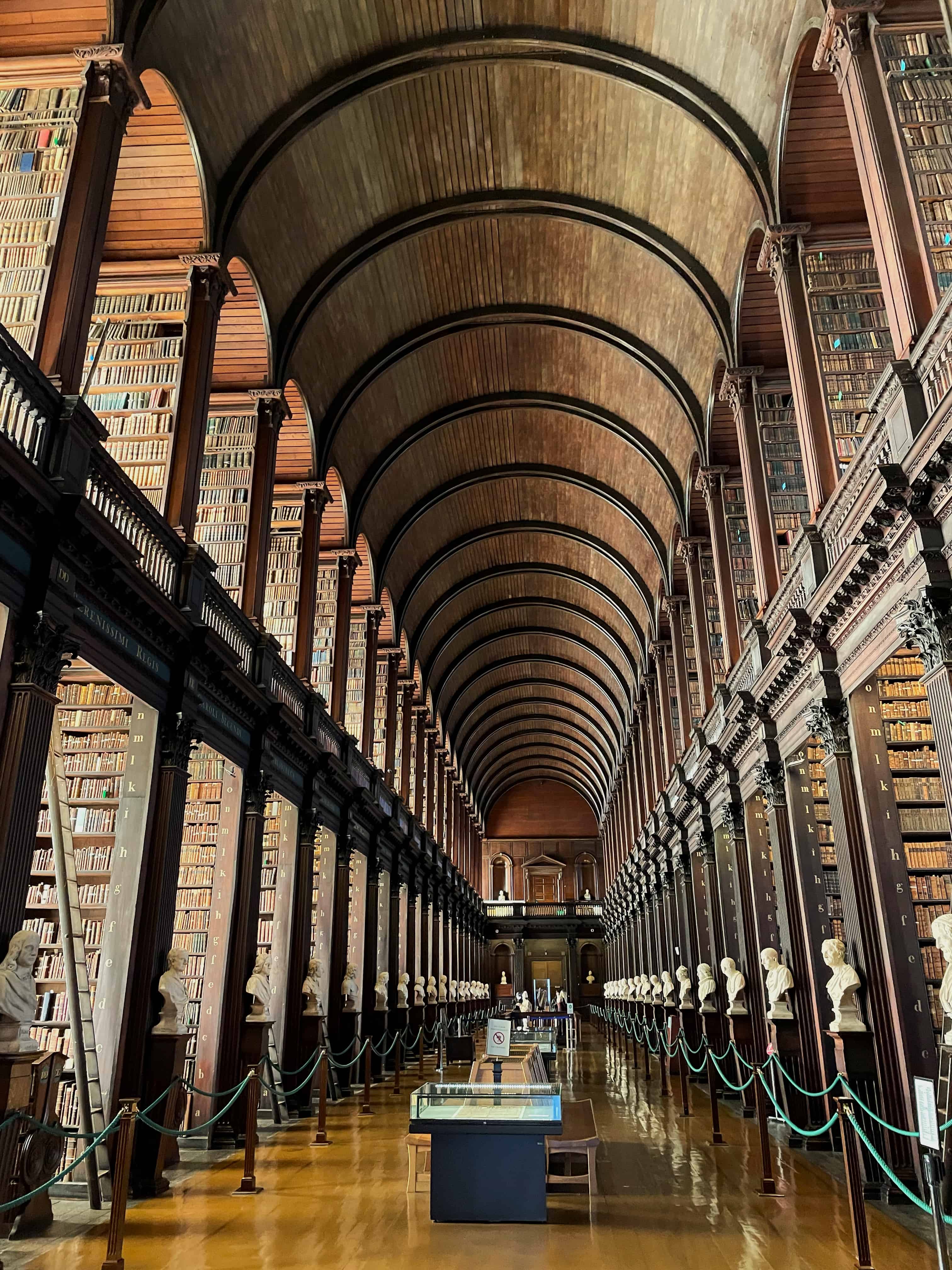
22. The Book of Kells and Library at Trinity College
Trinity College Dublin is the world’s 108th best university and a famous landmark of Dublin in its own right. Within the campus are two of the most famous landmarks in Ireland: the Library Long Room and the Book of Kells.
The library was constructed in the 18th century and houses an extensive collection of ancient manuscripts, priceless books, and historical documents. Boasting a stunning barrel-vaulted ceiling and rows upon rows of towering bookshelves, the Long Room serves as a repository of knowledge and cultural heritage.
The Book of Kells is a hand-painted religious manuscript dating back to the 9th century. It’s full of colorful and intricate designs, all painstakingly hand-drawn by Irish monks.
The Books of Kells and Trinity Library are visited together and are one of the most visited attractions in Dublin (second only to the Guinness Storehouse). Be sure to book your ticket online in advance as this popular site books up days ahead.
23. Grafton Street
Grafton Street is a vibrant thoroughfare in Dublin and the city’s main shopping street. This lively street, once mainly residential, has evolved into a bustling hub of high-end shopping and entertainment.
Lined with an array of upscale shops, boutiques, and department stores, Grafton Street draws in locals and tourists alike. The street is renowned for its energetic atmosphere, teeming with talented street performers and musicians who entertain the crowds.
Grafton Street is fun year-round, but my favorite time to stroll here is in December when the street is lit up with Christmas lights. Dublin in the winter months can be a magical time, despite the dreary, short days.
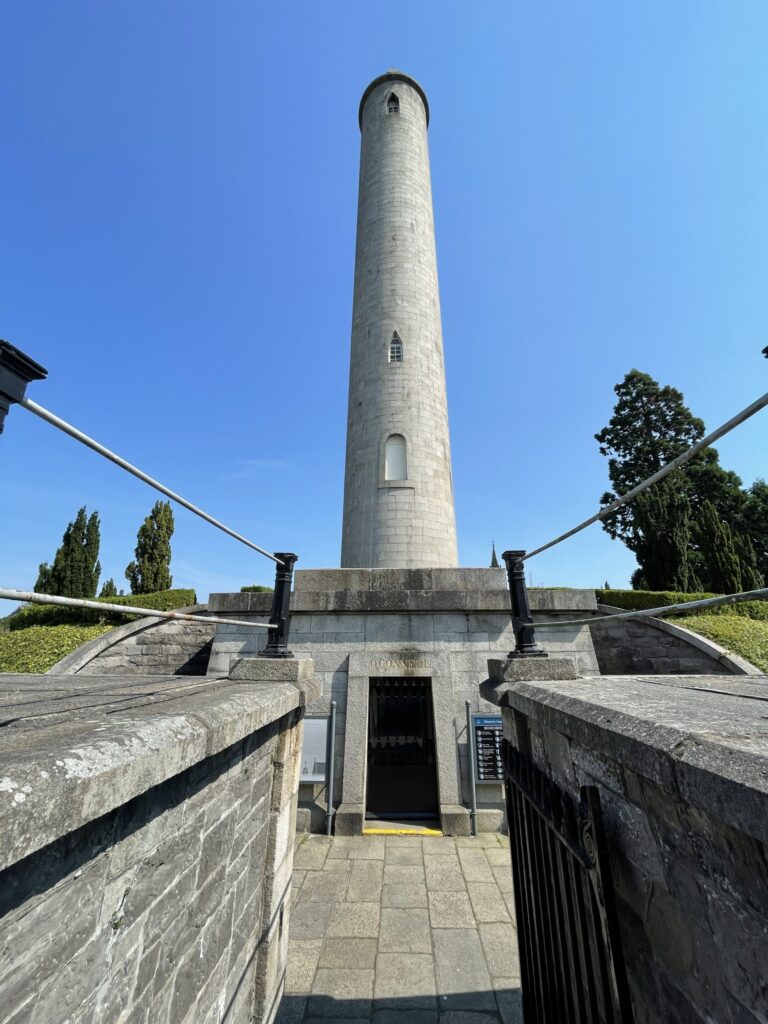
24. Glasnevin Cemetery
Glasnevin Cemetery holds immense historical significance as the final resting place for many notable Irish figures. The cemetery opened in 1832, alongside the National Botanic Gardens, and the first burial there was an 11-year-old boy named Michael Carey.
Since then, numerous influential Irish figures have been laid to rest in Glasnevin, including political leaders like Charles Stewart Parnell and Eamon de Valera, revolutionaries like Michael Collins, and literary figures like Brendan Behan.
One of the most prominent features of the cemetery grounds is the O’Connell Tower, erected in honor of Daniel O’Connell who advocated for Irish independence. Nicknamed “The Liberator,” he campaigned for Catholic rights in Ireland and secured the first installment of Catholic emancipation in 1829. The towering monument, built to resemble a traditional Irish round tower, stands as a tribute to O’Connell’s legacy.
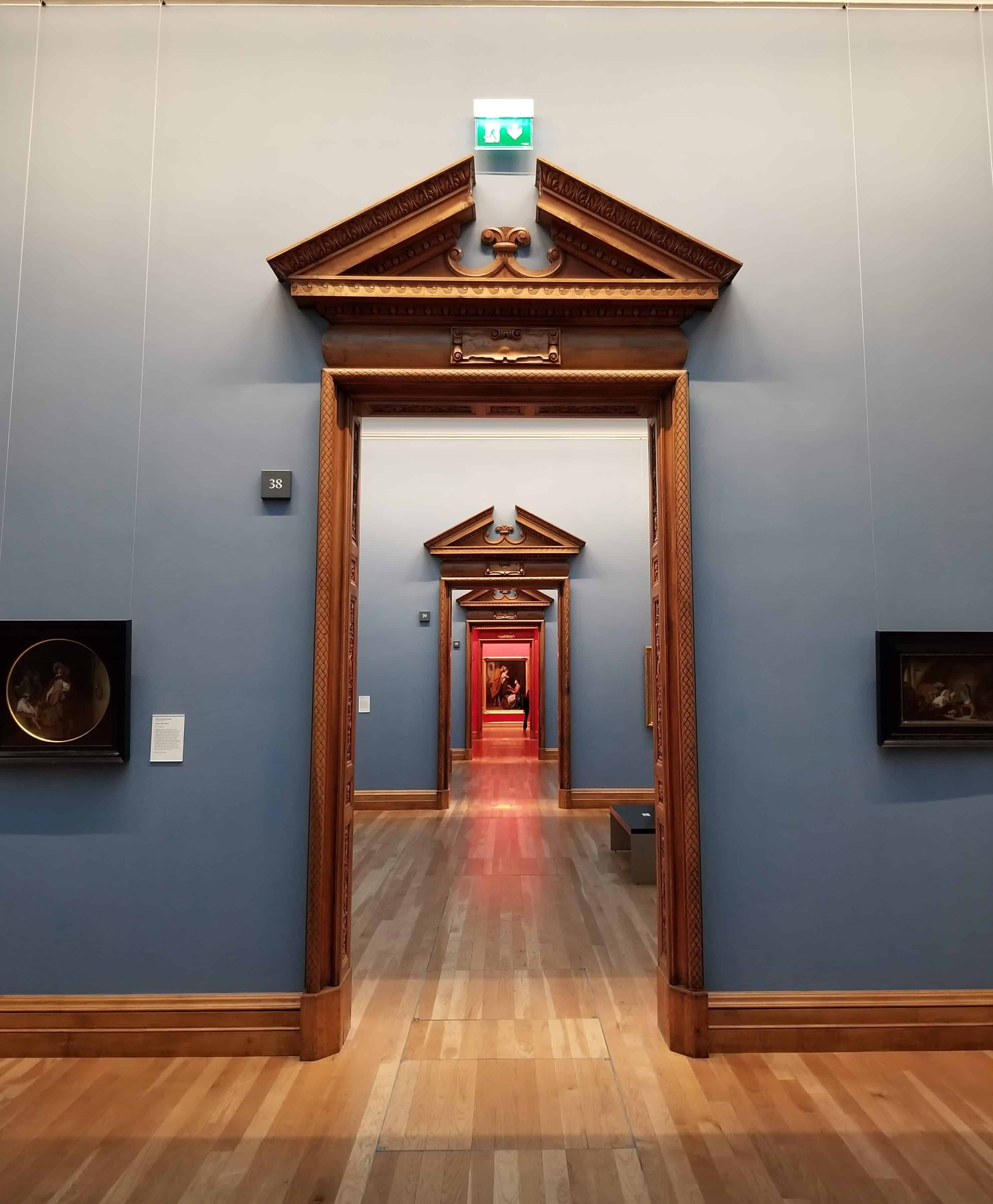
25. National Museum of Ireland – The National Gallery
The National Gallery of Ireland is a cornerstone of the city’s artistic heritage, tracing its origins to the mid-19th century. Housing an extensive collection of artworks spanning various periods, the gallery holds significant paintings by renowned Irish artists, showcasing the country’s rich artistic legacy.
Among the many painters featured in the gallery’s collection is Jack B. Yeats, one of Ireland’s most famous artists. Known for his vibrant and evocative works capturing scenes of Irish life, Yeats’ paintings are prominently displayed within the gallery’s halls.
The National Gallery displays masterpieces by Irish artists alongside an impressive array of European artworks. It’s also one of Dublin’s many free museums, making it a worthwhile stop on any Dublin itinerary.
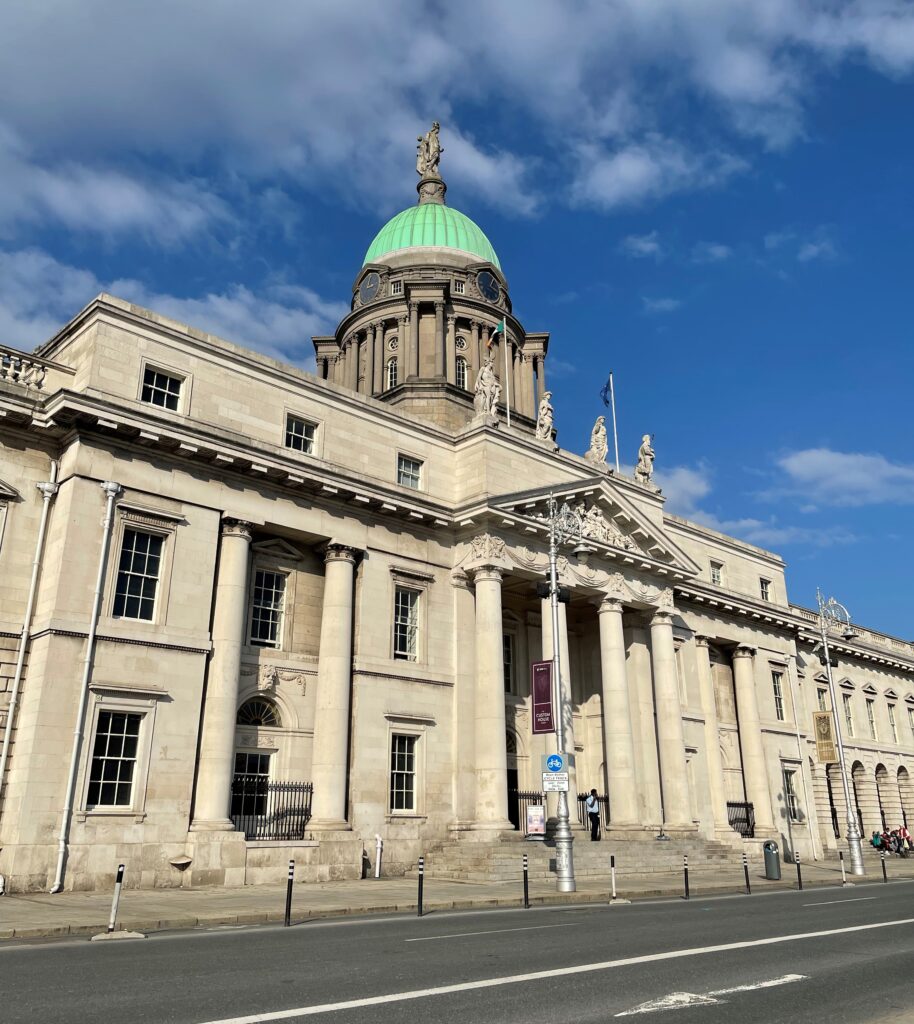
26. Custom House
The original Custom House was controversial when it was built and subsequently burned down during the War of Independence.
Originally completed in the late 18th century, this neoclassical masterpiece was designed by architect James Gandon. Situated along the River Liffey, its symmetrical façade and elegant design reflect the grandeur and precision of Georgian architecture.
The building played a pivotal role in overseeing trade and taxation during Ireland’s economic growth. After its destruction during the Irish War of Independence in 1921, the Custom House was meticulously restored to its former glory.
Today, the building is a government office housing various departments, but you can visit the newly opened Custom House Visitor Centre to learn more about the building and Irish history.
27. Samuel Beckett Bridge
The Samuel Beckett Bridge spans the River Liffey, welcoming visitors to the heart of Dublin city. Opened in 2009, this eye-catching bridge is shaped like a harp, paying homage to Ireland’s national symbol.
The bridge is easily one of the most recognizable monuments in Dublin, and the most famous of the many bridges that cross the Liffey. The Beckett Bridge has become an integral part of the city’s landscape and represents modern progress in this historic city.
28. Department of the Taoiseach
In central Dublin, the Department of the Taoiseach is a significant city landmark. This building serves as the official office of the Irish Prime Minister, known as the Taoiseach (pronounced tea-shock). Located on Merrion Street, this historic structure has played a crucial role in Ireland’s governance since its completion in the early 20th century.
The complex of buildings houses the offices of the Taoiseach and senior government officials. It serves as a central hub for policy-making, administrative functions, and governmental decision-making.
The Department of the Taoiseach is integral to the functioning of the Irish government. This is the political nerve center of Ireland, notably located in the center of the capital city.
29. Dublin Port
When thinking of famous Dublin landmarks, Dublin Port is probably not the first thing to come to mind. While this working port is not a place you can visit, it’s still a vital city landmark with an important history deeply intertwined with Ireland’s economic and cultural growth.
The port here dates back centuries and has been a crucial hub for trade and maritime activities, playing a pivotal role in Dublin’s development.
Dublin’s port is one of the busiest ports in Europe. Over 50% of the nation’s household products are imported, and every one of those items enters through this port. It serves as a gateway for goods and commodities, facilitating trade connections with various nations across the globe.
While you can’t just stroll into the port, you can see it well from the water by taking a Dublin Harbor tour. These tours operate seasonally from spring to fall, and I highly recommend them as a way to learn about Dublin’s history and see the port from the water.
30. Pearse Museum
The Pearse Museum honors the legacy of Patrick Pearse, a key figure in Ireland’s fight for independence.
Located in his former family home which Pearse transformed into an Irish language school called St. Enda’s, the museum preserves Pearse’s memory and his pivotal role in shaping Irish history. As a leader of the 1916 Easter Rising, Pearse was a fierce advocate for Irish sovereignty.
During a visit to the museum, visitors will learn about the Pearse family and the ethos of St. Enda’s School. Exhibits showcase Pearse’s writings, personal belongings, and the school’s artifacts, offering insight into his educational vision and commitment to Irish heritage.
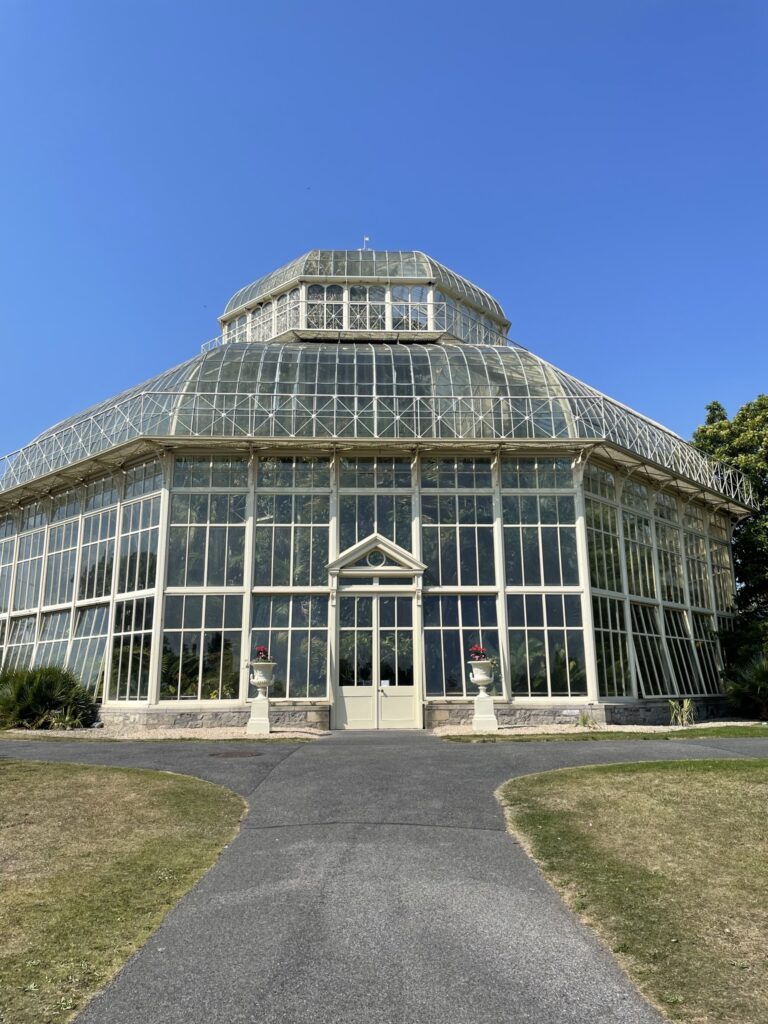
31. National Botanic Gardens
Dublin’s National Botanic Gardens were established in 1795 and originally founded to promote scientific research and horticultural knowledge. Over the years, they have evolved into a sanctuary for diverse plant species and a hub for education, conservation, and public enjoyment.
The gardens are free to visit and wander, making them the perfect activity for anyone looking to enjoy a rare nice-weather day. While there, you can enjoy vast expanses of greenery and colorful plant collections. The gardens are especially beautiful in March when the spring bulbs bloom and green leaves return to the trees.
The Victorian glasshouses are a real highlight, housing exotic tropical plants inside the original Victorian structures. These are some of the oldest Victorian glasshouses in the world and iconic Dublin monuments.
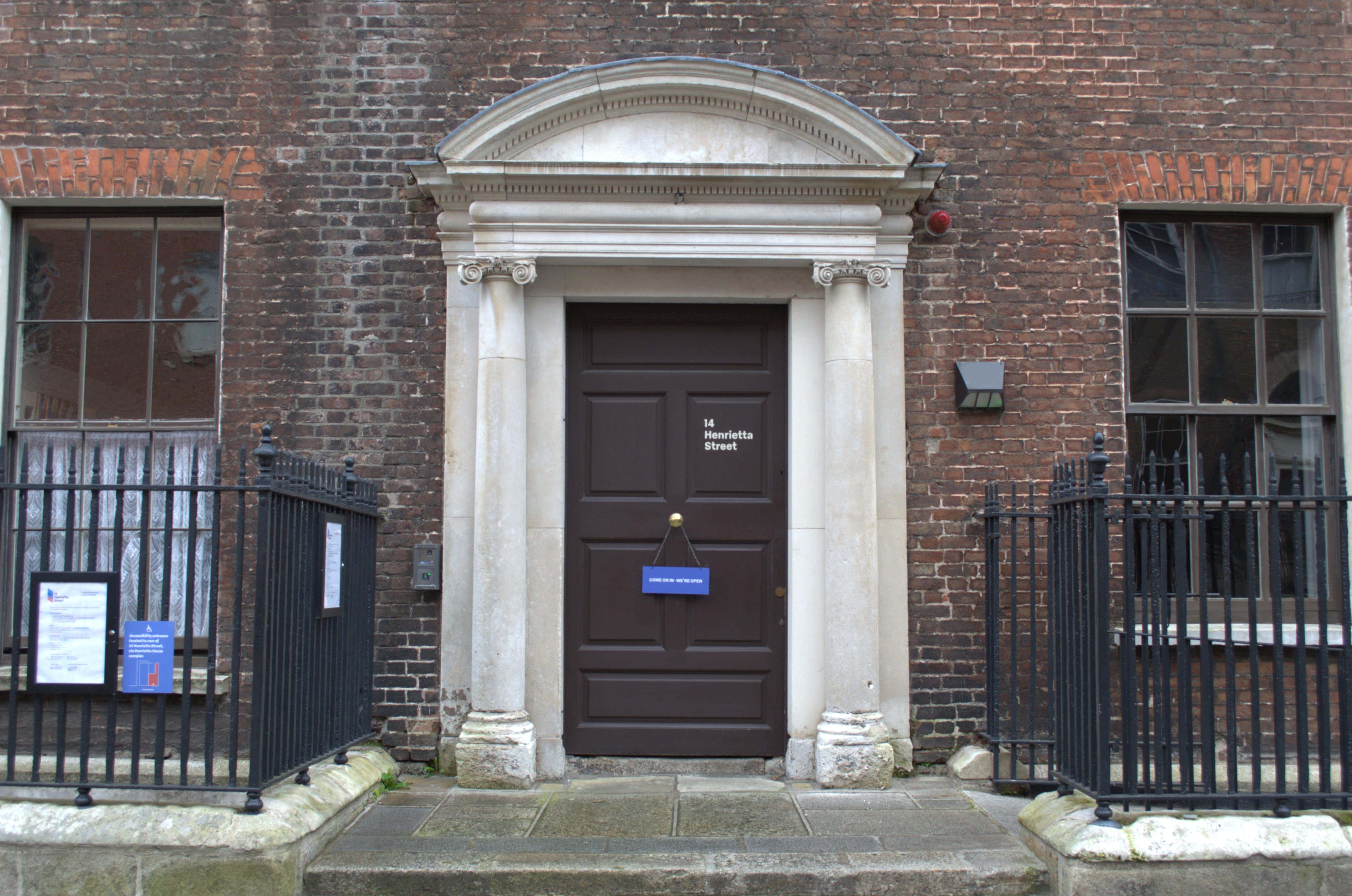
32. 14 Henrietta Street
The museum at 14 Henrietta Street is a sobering reminder of the hardships faced by Dubliners in the early 20th century. Often described as the Irish Tenement Museum, Henrietta Street walks visitors through Dublin’s history and brings them face-to-face with the impoverished families crammed into these once-elegant Georgian buildings.
This is one of my favorite museums in Dublin as it focuses on the individuals living in the building. The tour guides are passionate about this history, and many have personal connections through family members who grew up in similar conditions. This moving museum is one I recommend to everyone who visits me, even though it’s not in the safest part of Dublin.
33. Marsh’s Library
Marsh’s Library was established in the early 18th century and is one of the oldest public libraries in Ireland.
Founded by Archbishop Narcissus Marsh, the library pioneered the idea of offering public access to its collection during a time when libraries were predominantly private.
Today, the library’s interior maintains its original design, with oak bookcases and wooden galleries. The collection spans centuries, housing rare manuscripts, early printed books, and historical documents.
Visitors can explore the aisles and marvel at the ancient works. The library is a treasured city landmark, preserving knowledge and offering a tranquil escape from the noisy city streets.
34. Farmleigh Estate
Farmleigh Estate sits at the edge of Phoenix Park, not far from Dublin Zoo, and was once the home of the Guinness family. Originally purchased by Edward Cecil Guinness in 1873, the estate served as the family’s private residence and housed four generations of the Guinness family.
Today, Farmleigh Estate is an OPW site open to visitors year-round. It also serves as a venue for hosting state events, including diplomatic meetings and state dinners for foreign dignitaries. Its beautifully landscaped grounds, historic architecture, and connection to the influential Guinness family make Farmleigh Estate a cherished site, preserving a rich slice of Dublin’s history.
35. Molly Malone Statue
The Molly Malone statue is on every tourist’s list of what to see in Dublin. The statue honors the fictional protagonists from the famous Irish song “Molly Malone” or “Cockles and Mussels.” The statue depicts Molly as a fishmonger, wheeling her cart through the streets of Dublin.
The song, often considered a Dublin anthem, reflects the hardship of Irish life in the 17th century. Molly’s story embodies the struggles of the working class, spending long days laboring and succumbing to deadly illnesses.
While the statue was undoubtedly erected to pay tribute to the hard-working people of the city, most people seem to fixate on how well-endowed Molly is. It’s impossible to walk by this statue and not see tourists posing for pictures while cupping Molly’s breasts.
36. James Joyce Statue
James Joyce was an acclaimed Irish author renowned for his groundbreaking work, “Ulysses.” His statue on North Earl Street pays tribute to Joyce, depicting him stopped, mid-stroll, much like Leopold Bloom, the protagonist of Joyce’s seminal work, “Ulysses,” on his famed walk through Dublin.
“Ulysses,” a monumental novel published in 1922, intricately weaves through a day in the life of Leopold Bloom, walking the streets of Dublin, immortalizing the city as a character in itself.
Joyce’s innovative writing style and intricate portrayal of Dublin have solidified his legacy as one of the most influential Irish literary figures of the 20th century. The statue serves as a reminder of Joyce’s connection to Dublin and his lasting influence on literature.
37. Famine Memorial
The Irish Famine was a devastating time in Irish history, claiming the lives of over 1 million people and forcing the emigration of another 1 million. This dark period has had a lasting impact on Irish society, the effects of which can still be felt today.
The Famine Memorial is a haunting sculpture that pays tribute to the victims of this time. The gaunt, starved figures walk along the riverbank, faces full of anguish. The memorial serves as a poignant reminder of the immense human tragedy and the enduring impact of the famine on Ireland’s population and history. Its significance lies in commemorating the resilience of the Irish people, honoring those who suffered and perished, and ensuring that the memory of this harrowing period remains alive in the collective consciousness of the city and the nation.
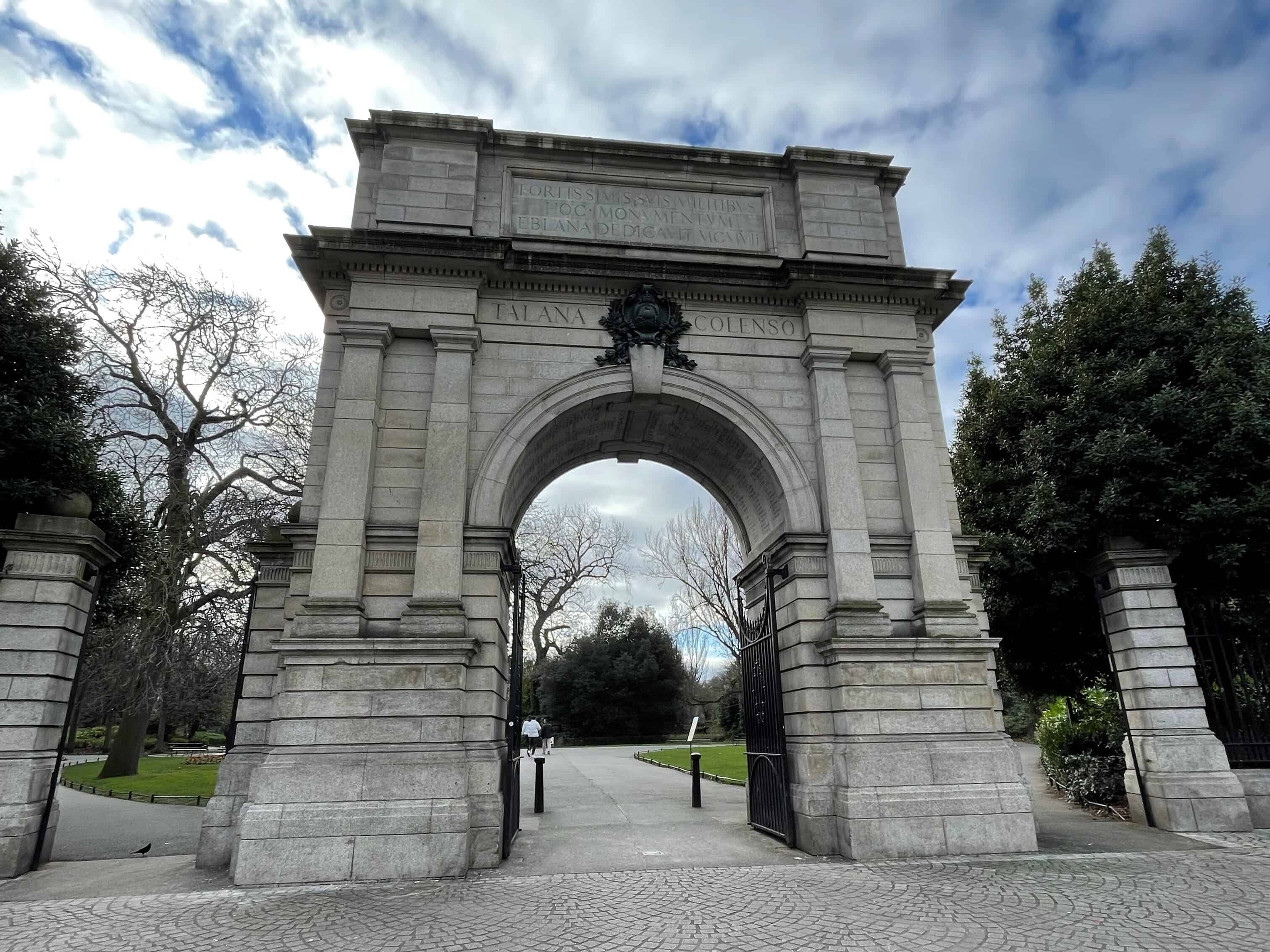
38. St Stephen’s Green
St. Stephen’s Green is a cherished green space within the city. Initially established in the 17th century, this serene park was donated to the people of Dublin by the Guinness family.
The park also plays a distinct role in Irish history. It served as a battleground during the Easter Rising when rebels dug trenches in the park and exchanged fire with British forces across the street in the Shelbourne Hotel.
Today, St. Stephen’s Green is a beautiful and tranquil place to stroll and enjoy a beautifully manicured park. It’s one of the best Dublin parks and is easily accessible while in the city center.
39. Merrion Square
Another one of Dublin’s beautiful green spaces is Merrion Square. The park was built as part of the city’s Georgian architectural expansion, surrounded by elegant townhouses. Originally designed as a private garden for the square’s residents, it eventually opened to the public and has been a cherished city landmark since.
Over the years, Merrion Square evolved into a hub for cultural and social gatherings. Every Thursday, the park hosts a lunchtime market, with food trucks representing cuisine from around the world. In December, the park hosts the Dublin Lights celebration, where visitors can enjoy a festive display of light after dark.
FAQ: Famous Landmarks in Dublin
The most famous landmark in Dublin is the Guinness Storehouse, a historic brewery that now serves as a popular visitor attraction, showcasing the history of Guinness and offering panoramic views of the city from its Gravity Bar.
The oldest landmark in Dublin is Dublin Castle, originally built in the 13th century as a defensive fortification. The castle is one of the most important landmarks in Dublin as well, having served various purposes throughout history.
Dublin is famous for its rich literary heritage, vibrant culture, and lively pub scene. Dublin is also home to Trinity College and the Guinness Storehouse, making it a hub for literature, history, and brewing.
The oldest part of Dublin is the area around Dublin Castle. It was originally founded as a Viking fortress in the 10th century, making it one of the earliest settlements in the city.
Some of the famous landmarks in Dublin include the Guinness Storehouse, Trinity College and the Book of Kells, Dublin Castle, St. Patrick’s Cathedral, and the Ha’penny Bridge.
In Dublin, the best historical sights are found in the city center and include Trinity College, Dublin Castle, the National Gallery, and Christ Church Cathedral.
Final Thoughts on Famous Dublin Landmarks
Dublin is a great city, steeped in history and full of craic. The capital of Ireland has many famous and popular historical landmarks that will enrich any trip to Dublin. Many of these historical landmarks are conveniently located in the bustling heart of the city and are easy to see while exploring Dublin on foot. Whether you’re interested in famous statues, grabbing a drink in the Temple Bar area, or just wandering through the city’s green spaces, history can be found around every corner. I hope this guide to Dublin’s famous landmarks has given you some insight into Irish history and inspiration for your next trip to Dublin.
